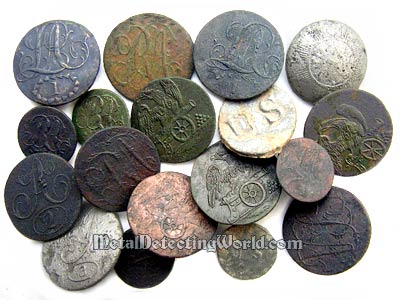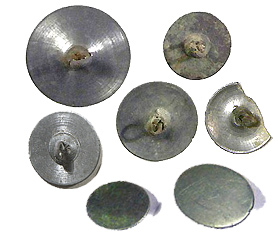Military Uniform and Civilian Buttons
General Types of Military Uniform and Civilian Buttons, Info on Hessian Buttons, and Photo Galleries of Buttons Found with a Metal Detector in the US and Abroad
Shown in photo galleries are civilian buttons, military uniform buttons of American Rev War, US 1812 War, US Civil War, and buttons of Imperial Russia.
General Types of Military Uniform and Civilian Buttons, circa 18-19th Century
by Sergei UpstateNY, last time modified:

Buttons of this period can be divided into three general types:
Type I represents the 1-piece flat buttons made by either 1) casting metal (lead, pewter, or brass) in a mold which also provided an integral eyelet; in some buttons the hole in the shank was drilled, or 2) striking the device on a brass disk; a wire eyelet or loop shank was fastened by brazing.
Type II represents the 2-piece convex buttons. This type was invented by Benjamin Sanders of Birmingham, England in 1813. The button was made of two pieces, a front shell upon which the device was struck, and a back plate to which a wire eyelet or loop shank was fastened by brazing. The two parts were fastened together by turning the edge of the front shell over the back piece.
Type III represents the staff buttons that are usually gilt, convex, with the device on a lined field. This type was first produced by the Scovill Company in the 1830's, for the army staff officers. The buttons are similar to the buttons of type II except that the front shell and back piece are held together by a separate narrow flat rim.
Hessian Buttons

The "Hessian buttons" are also called "tomback buttons" and usually found along with relics, circa mid-18th to early 19th centuries, at the metal detecting sites predominantly in the North-East USA. Unfortunately there is a lack of information on the origin and design of this type of buttons on the Web. I did a little research and found a few small pieces of information on this subject:
Large contingents of German troops, commonly lumped together under the term "Hessians", were hired by the British during the Revolution to fight in North America. The army force maintained here by the King comprised 35% of the Hessians drawn mainly from the principalities of Hesse Cassel, Brunswick, Hesse Hanau, Waldeck, and other smaller German states.
Buttons from all of these regiments were plain, and without any sort of unit designation. Flat-faced with a very pronounced boss on the backs, into which an iron-wire eye was anchored, these buttons originally were made of tombac (or "tombak" - another name for the copper/zinc alloy), or thin brass, depending on the color of the regiments' metal.
During the Rev War period, the regulation white-metal buttons, identical to Hessian buttons, were imported (until 1793) from Birmingham (England) and worn by the ranks of the British Army. Also, it is reasonable to assume that flat or solid white-metal buttons of this type were cast in sand or in two- or three-piece hand molds (somewhat akin to those used in making bullets) by colonial metal workers throughout most of the eighteenth century.
As the eighteenth century progressed, the Hessian buttons became both larger and more common. Most buttons have brass or copper wire loop shanks. As a rule, they are virtually indistinguishable from civilian buttons of the same period. The latter were in use until the late 1900s.
